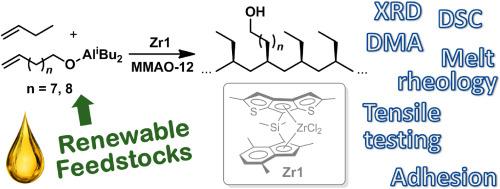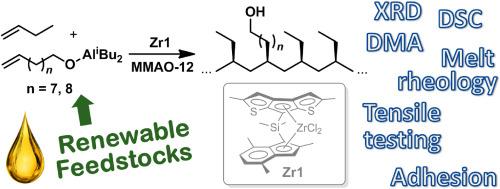丁-1-烯与极性乙烯单体的等规共聚:ω-烯-1-醇共聚物含量对功能化聚丁-1-烯的相行为、熔体流变性、力学和粘接性能的影响
IF 4.5
2区 化学
Q2 POLYMER SCIENCE
引用次数: 0
摘要
首次研究了以iBu3Al和MMAO-12为催化剂,c1对称反异茂物[Me2Si(η - 5-2,4,7-三甲基烯-1-基)(η - 5-2,5-二甲基- 7h -环戊[1,2-b:4,3-b']二噻吩-7-基)]ZrCl2 (Zr1)催化丁烯与生物基十一-10-烯-1-醇(M1),十二-9-烯-1-醇(M2)及其硅基酯(M3-M5)]的等规共聚反应。在[AlMMAO]/[Zr1] = 40和[单体]/[Zr1] = 5000时,ibu2al保护的ω-烯烃-1-ol表现出最高的活性,单体掺入度高达16.7 mol%,形成具有中等立体规则的(co)聚合物(对于等规聚(丁烯)iPB Tm = 93.3℃)。当[AlMMAO]/[Zr1] = 400,[单体]/[Zr1] = 100,000时,形成Tm = 102.9℃的iPB;ibu2al保护的十一-10-烯-1-醇(M1- al)的存在导致(co)聚合物的Mn从229 kDa (iPB)大幅增加到1193 kDa(含3.6 mol% M1的共聚物)。对(co)聚合物的XRD和DSC研究表明,低单体含量对iPB中Form II到Form I的转变速率有积极影响。羟基含量为0.3 ~ 0.6 mol%的共聚物具有较好的熔体流变性和力学性能,而M1含量为2.0 mol%的共聚物是一种钢用热熔胶,其粘接强度比商用聚乙烯-醋酸乙烯酯高1.5倍。本文章由计算机程序翻译,如有差异,请以英文原文为准。


Isotactic copolymerization of but-1-ene with polar vinyl monomers: the effect of ω-alken-1-ol comonomer content on phase behavior, melt rheology, mechanical and adhesive properties of functionalized poly(but-1-ene)s
Isotactic copolymerization of but-1-ene with bio-based undec-10-en-1-ol (M1), dec-9-en-1-ol (M2) and their silyl esters (M3–M5), catalyzed by C1-symmetric ansa-heterocene [Me2Si(η5-2,4,7-trimethelinden-1-yl)(η5-2,5-dimethyl-7H-cyclopenta[1,2-b:4,3-b']dithiophen-7-yl)]ZrCl2 (Zr1), activated by iBu3Al and MMAO-12, was explored for the first time. At [AlMMAO]/[Zr1] = 40 and [Monomer]/[Zr1] = 5,000, iBu2Al-protected ω-alken-1-ols have demonstrated highest activities and up to 16.7 mol% degrees of the comonomer incorporation with a formation of (co)polymers with moderate stereoregularity (for isotactic poly(but-1-ene) iPB Tm = 93.3 °C). At [AlMMAO]/[Zr1] = 400 and [Monomer]/[Zr1] = 100,000, iPB with Tm = 102.9 °C was formed; the presence of iBu2Al-protected undec-10-en-1-ol (M1-Al) led to substantial increase of the Mn of (co)polymers from 229 kDa (iPB) to 1193 kDa (copolymer containing 3.6 mol% of M1). XRD and DSC studies of the (co)polymers revealed a positive impact of the low comonomer content on the rate of Form II to Form I transition in iPB. Copolymers containing 0.3–0.6 mol% of OH groups showed improved melt rheology and mechanical properties, while the copolymer with 2.0 mol% M1 content turned out to be a hot-melt adhesive for steel with one and a half times higher bonding strength than commercial poly(ethylene-co-vinyl acetate).
求助全文
通过发布文献求助,成功后即可免费获取论文全文。
去求助
来源期刊

Polymer
化学-高分子科学
CiteScore
7.90
自引率
8.70%
发文量
959
审稿时长
32 days
期刊介绍:
Polymer is an interdisciplinary journal dedicated to publishing innovative and significant advances in Polymer Physics, Chemistry and Technology. We welcome submissions on polymer hybrids, nanocomposites, characterisation and self-assembly. Polymer also publishes work on the technological application of polymers in energy and optoelectronics.
The main scope is covered but not limited to the following core areas:
Polymer Materials
Nanocomposites and hybrid nanomaterials
Polymer blends, films, fibres, networks and porous materials
Physical Characterization
Characterisation, modelling and simulation* of molecular and materials properties in bulk, solution, and thin films
Polymer Engineering
Advanced multiscale processing methods
Polymer Synthesis, Modification and Self-assembly
Including designer polymer architectures, mechanisms and kinetics, and supramolecular polymerization
Technological Applications
Polymers for energy generation and storage
Polymer membranes for separation technology
Polymers for opto- and microelectronics.
 求助内容:
求助内容: 应助结果提醒方式:
应助结果提醒方式:


